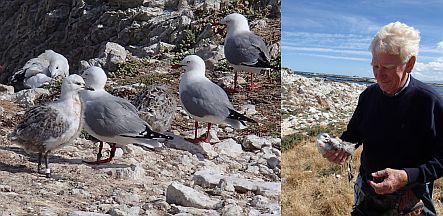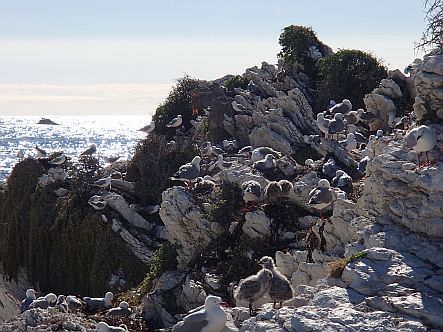By Alison Ballance

The red-billed gull chick (left) has a metal leg band put on by researcher Jim Mills (image: A. Ballance)
Biologist Jim Mills has been studying red-billed gulls at Kaikoura for the last 49 years. Every summer since 1964 Jim and various assistants, including his wife Deborah, have visited the gull colony for several months to record the breeding success of colour-banded gulls and their offspring. Jim currently has around 500 colour-banded birds, and over the course of the study he has banded more than 5000 birds. This is one of only a few studies world-wide that have been going for so long, and for the last couple of decades Jim and Deborah have carried out the field work in their own time.
This long term data set, which covers up to seven generations of birds in the same family, has yielded much surprising information about the birds. The longest lived bird in the study was 31 years old, with many birds reaching 29 or 30 years. There have been no recorded cases of inbreeding, and most birds are very monogamous, having just one or two partners during their life. Only 3% of clutches have eggs fathered by a male other than the male at the nest.
During the study the gull colony at Kaikoura has declined by 51%, due to predation by cats and ferrets, as well as a succession of El Nino events during which warm water prevented gulls reaching their favoured food of krill, causing breeding to fail. A recent paper in Notornis shows that during the same period the number of breeding red-billed gulls in Otago has risen dramatically.
Data from the gulls was recently combined with that from other long-term seabird studies in a landmark paper published in Science that showed that successful long-term seabird breeding relied on forage fish stocks being maintained at one third of the maximum prey biomass.

Red-billed gull colony at Kaikoura, late in the breeding season with chicks that are a few days away from fledging (image: A. Ballance)

